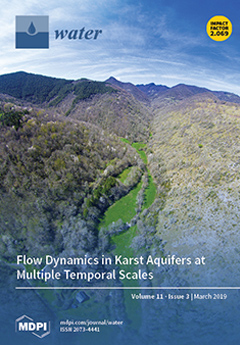In this study, the relative efficiency of four forms of supported titanium dioxide (TiO
2) as a photocatalyst to degrade 2,4-dichlorophenoxyacetic acid (2,4-D) in Killex
®, a commercially available herbicide was studied. Coated glass spheres, anodized plate, anodized mesh, and electro-photocatalysis
[...] Read more.
In this study, the relative efficiency of four forms of supported titanium dioxide (TiO
2) as a photocatalyst to degrade 2,4-dichlorophenoxyacetic acid (2,4-D) in Killex
®, a commercially available herbicide was studied. Coated glass spheres, anodized plate, anodized mesh, and electro-photocatalysis using the anodized mesh were evaluated under an ultraviolet – light-emitting diode (UV-LED) light source at λ = 365 nm in a semi-passive mode. Energy consumption of the system was used to compare the efficiency of the photocatalysts. The results showed both photospheres and mesh consumed approximately 80 J/cm
3 energy followed by electro-photocatalysis (112.2 J/cm
3), and the anodized plate (114.5 J/cm
3). Although electro-photocatalysis showed the fastest degradation rate (K = 5.04 mg L
−1 h
−1), its energy consumption was at the same level as the anodized plate with a lower degradation rate constant of 3.07 mg L
−1 h
−1. The results demonstrated that three-dimensional nanotubes of TiO
2 surrounding the mesh provide superior degradation compared to one-dimensional arrays on the planar surface of the anodized plate. With limited broad-scale comparative studies between varieties of different TiO
2 supports, this study provides a comparative analysis of relative degradation efficiencies between the four photocatalytic configurations.
Full article





